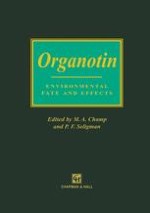1996 | OriginalPaper | Buchkapitel
Measurement and Significance of the Release Rate for Tributyltin
verfasst von : Paul Schatzberg
Erschienen in: Organotin
Verlag: Springer Netherlands
Enthalten in: Professional Book Archive
Aktivieren Sie unsere intelligente Suche, um passende Fachinhalte oder Patente zu finden.
Wählen Sie Textabschnitte aus um mit Künstlicher Intelligenz passenden Patente zu finden. powered by
Markieren Sie Textabschnitte, um KI-gestützt weitere passende Inhalte zu finden. powered by
Reliable measurement of the rate of release of tributyltin (TBT) from antifouling paints is important for a number of reasons, principally for minimizing the potential environmental impact on nontarget organisms. When the TBT is chemically bound to a key constituent of the paint, its release rate is controlled by the rate of hydrolytic cleavage of the chemical bond; therefore, the release rate becomes an intrinsic property of the paint. When the TBT is present as a mixed component of the paint, its rate of release is not controlled and often is much higher than necessary for antifouling performance.Laboratory measurements of the TBT release rate have shown that it can be measured reliably. These measurements provided the following information: (1) release rates of different paints range over several orders of magnitude; (2) freshly painted surfaces show an initial rate of release very much higher than the subsequent ‘steady-state’ rate; (3) temperature dependence of release rates demonstrated that the release mechanism involves a chemical reaction (hydrolysis) in those formulations where the TBT is chemically bound; (4) reduction in release rate when the pH is lowered also indicates that the primary mechanism is hydrolytic cleavage of the carboxyl-TBT bond, which releases the biocide allowing it to diffuse out; and (5) for the chemically bound TBT paint formulations, reducing their TBT content reduces the release rate as well as the surface softening and resulting hull smoothing. The rotating cylinder method for measuring the release rate in the laboratory has been applied by the US Environmental Protection Agency (US EPA) to regulate the use of TBT paints. This action achieved the following results: (1) paint suppliers became aware that the biocide release rate is an intrinsic property of the coating and has a direct bearing on evaluating potential environmental consequences from that product; (2) many TBT paints were found to have release rates unnecessarily high for antifouling protection and therefore placed an unnecessary burden on the environment; and (3) the US Congress, in enacting regulatory legislation, and the US EPA, in implementing such legislation, incorporated limits of TBT release rates as one key element in the regulatory action, removing thereby a large number of unacceptable products from the market and making a total ban unnecessary. Nevertheless, the rotating cylinder method appears to be flawed in that it simulates more closely the condition of a ship under way than a ship at rest in a harbor; consequently, very much higher biocide release rates are measured by this method than is actually the case. The rotating cylinder method, as it is currently used, can be improved by increasing the number of measurements and eliminating the current practice of regressing a single data point through the origin of the time-concentration plot to determine the rate of release.Release of TBT in the environment is complicated by the presence of a biological film on the painted surfaces. This biofilm or slime layer consists of a complex community of microorganisms that presents an attractive environment for large settling organisms such as barnacles or tubeworms. The microorganisms in the biofilm become acclimated to the TBT biocide. As TBT is released from the paint surface, it concentrates in the biofilm due to exudates from the microorganisms, creating a hostile chemical environment that prevents permanent attachment of fouling organisms.A novel, simple apparatus, easy to use in the laboratory or the field, has been developed to determine the minimum effective biocide release rate needed to prevent the attachment of settling organisms. The apparatus simulates different rates of release of biocides, and can be positioned in the marine environment and exposed to settling organisms. Data collected in this way will establish the optimum rate of release for a given biocide; that is, the minimum rate needed to prevent attachment by fouling organisms and at the same time to make a negligible impact on the environment. This information can then be used by paint chemists to formulate an antifouling paint with a high level of confidence that the new paint will perform well and meet regulatory requirements.
